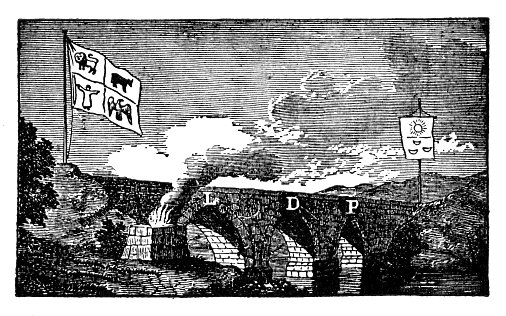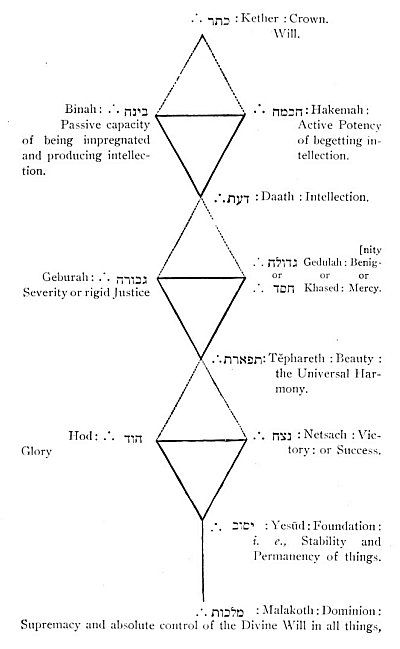AMUN, at first the God of Lower Egypt only, where Moshah was reared [a word that in Hebrew means Truth], was the Supreme God. He was styled “the Celestial Lord, who sheds Light on hidden things.” He was the source of that divine life, of which the crux ansata is the symbol; and the source of all power, He
p. 254
united all the attributes that the Ancient Oriental Theosophy assigned to the Supreme Being. He was the πλήρωμα (Pleroma), or “Fullness of things,” for He comprehended in Himself everything; and the LIGHT; for he was the Sun-God. He was unchangeable in the midst of everything phenomenal in his worlds. He created nothing; but everything emanated from Him; and of Him all the other Gods were but manifestations.
The Ram was His living symbol; which you see reproduced in this Degree, lying on the book with seven seals on the tracing-board. He caused the creation of the world by the Primitive Thought [Εννοια, Ennoia], or Spirit [Πνευμα, Pneuma], that issued from him by means of his Voice or the WORD; and which Thought or Spirit was personified as the Goddess NEITH. She, too, was a divinity of Light, and mother of the Sun; and the Feast of Lamps was celebrated in her honor at Sais. The Creative Power, another manifestation of Deity, proceeding to the creation conceived of in her, the Divine Intelligence, produced with its Word the Universe, symbolized by an egg issuing from the mouth of KNEPH; from which egg came PHTHA, image of the Supreme Intelligence as realized in the world, and the type of that manifested in man; the principal agent, also, of Nature, or the creative and productive Fire. PURE or RE, the Sun, or Celestial Light, whose symbol was ☉, the point within a circle, was the son of PHTHA; and TIPHE, his wife, or the celestial firmament, with the seven celestial bodies, animated by spirits of genii that govern them, was represented on many of the monuments, clad in blue or yellow, her garments sprinkled with stars, and accompanied by the sun, moon, and five planets; and she was the type of Wisdom, and they of the Seven Planetary Spirits of the Gnostics, that with her presided over and governed the Sublunary world.
In this Degree, unknown for a hundred years to those who have practised it, these emblems reproduced refer to these old doctrines. The lamb, the yellow hangings strewed with stars, the seven columns, candlesticks, and seals all recall them to us.
The Lion was the symbol of ATHOM-RE, the Great God of Upper Egypt; the Hawk, of RA or PHRE; the Eagle, of MENDES; the Bull, of APIS; and three of these are seen under the platform on which our altar stands.
The first HERMES was the INTELLIGENCE or WORD of God. Moved with compassion for a race living without law, and wishing
p. 255
to teach them that they sprang from His bosom, and to point out to them the way that they should go [the books which the first Hermes, the same with Enoch, had written on the mysteries of divine science, in the sacred characters, being unknown to those who lived after the flood], God sent to man OSIRIS and Isis, accompanied by THOTH, the incarnation or terrestrial repetition of the first HERMES; who taught men the arts, science, and the ceremonies of religion; and then ascended to Heaven or the Moon. OSIRIS was the Principle of Good. TYPHON, like AHRIMAN, was the principle and source of all that is evil in the moral and physical order. Like the Satan of Gnosticism, he was confounded with Matter.
From Egypt or Persia the new Platonists borrowed the idea, and the Gnostics received it from them, that man, in his terrestrial career, is successively under the influence of the Moon, of Mercury, of Venus, of the Sun, of Mars, of Jupiter, and of Saturn, until he finally reaches the Elysian Fields; an idea again symbolized in the Seven Seals.
The Jews of Syria and Judea were the direct precursors of Gnosticism; and in their doctrines were ample oriental elements. These Jews had had with the Orient, at two different periods, intimate relations, familiarizing them with the doctrines of Asia, and especially of Chaldea and Persia;–their forced residence in Central Asia under the Assyrians and Persians; and their voluntary dispersion over the whole East, when subjects of the Seleucidæ and the Romans. Living near two-thirds of a century, and many of them long afterward, in Mesopotamia, the cradle of their race; speaking the same language, and their children reared with those of the Chaldeans, Assyrians, Medes, and Persians, and receiving from them their names (as the case of Danayal, who was called Bæltasatsar, proves), they necessarily adopted many of the doctrines of their conquerors. Their descendants, as Azra and Nahamaiah show us, hardly desired to leave Persia, when they were allowed to do so. They had a special jurisdiction, and governors and judges taken from their own people; many of them held high office, and their children were educated with those of the highest nobles. Danayal was the friend and minister of the King, and the Chief of the College of the Magi at Babylon; if we may believe the book which bears his name, and trust to the incidents related in its highly figurative and imaginative style. Mordecai,

Moe is the founder of GnosticWarrior.com. He is a father, husband, author, martial arts black belt, and an expert in Gnosticism, the occult, and esotericism.







